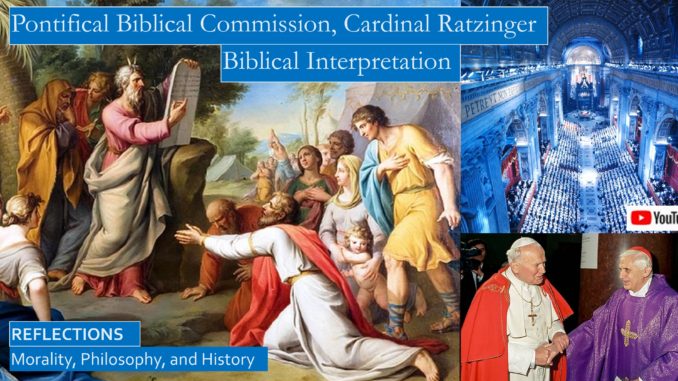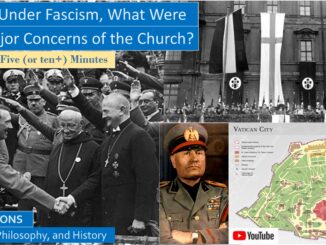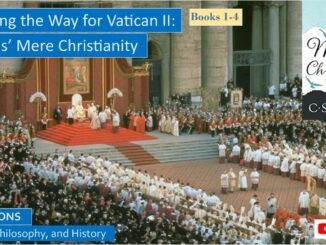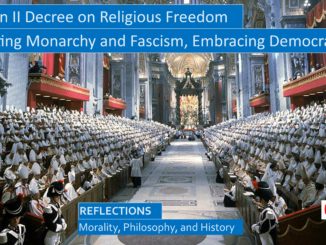
Historically, the Catholic Church has defended itself from attacks, both real and imagined, from enemies of the faith, and this defensiveness also extended to Biblical studies. The twentieth century saw a relaxing of this defensiveness, culminating in the decree Dei Verbum pronounced by Vatican II, encouraging Catholic scholars to use more modern methods of interpreting the Scriptures, under the guidance of the Vatican office, the Pontifical Biblical Commission.
Even if you are not Catholic this blog will be helpful in reflecting how to read and interpret Scripture to strengthen your faith.
Please view our YouTube video, it contains additional observations not in this blog: https://youtu.be/6jwUNScn_sM
In 1994 the Pontifical Biblical Commission issued the decree, The Interpretation of the Bible in the Church, signed by Cardinal Ratzinger, who later became Pope Benedict. This is more readable than the typical Vatican document. We highly encourage that you study this decree for yourself, especially if you are not familiar with the history of biblical criticism. Vatican decrees are written both for guidance to bishops and to instruct the church as a whole, and this decree also discusses a few arcane interpretation methods, you can skip over these sections.
We have two blog series that affect biblical interpretation that we highly encourage you review. We have also included book references for these blogs.
A foundational study in Biblical interpretation was penned by St Augustine, his On Christian Doctrine, also known as On Christian Teaching. St Augustine teaches us that a method of biblical interpretation is valid only if it increases in the heart of the believer their Love of God. These blogs are at: http://www.seekingvirtueandwisdom.com/category/st-augustine-on-christian-doctrine/
The Catholic Church views with caution the “historical Jesus” movement. Our blogs on this topic include a theological and social history of how biblical interpretation affected from the Protestant Reformation to the era of the GI Bill after World War II. These blogs are at: http://www.seekingvirtueandwisdom.com/category/historical-jesus/
The Vatican decree on The Interpretation of the Bible in the Church begins with a short history of the historical-critical method of biblical interpretation, which strives to unravel the historical meanings of the biblical text, and the Catholic response.
We will let the opening paragraphs speaks of the modern dilemma: “The study of the Bible is the soul of theology, as the Second Vatican Council says, borrowing a phrase from Pope Leo XIII (Dei Verbum, 24). This study is never finished; each age must, in its own way, newly seek to understand the sacred books.
In the history of interpretation, the rise of the historical-critical method opened a new era. With it, new possibilities for understanding the biblical word in its originality opened up. Just as with all human endeavor, though, so also this method contained hidden dangers along with its positive possibilities. The search for the historical original can lead to putting the word back into the past so completely that” the Scriptures no longer speak to us. “It can result that only the human dimension of the word appears as real, while the genuine author, God, is removed” from the very Scriptures He inspired.
There are two types of historical-critical interpretation, lower or textual criticism, and the various types of higher or literary criticism. No Christian denomination, regardless of their theological perspective, can avoid the necessity of lower or textual criticism, because it seeks the proper Greek or Hebrew base text that best reflects the original text. The earliest manuscripts we have were copies of earlier manuscripts many centuries after the original text was rendered.
LOWER OR TEXTUAL CRITICSM
We have very early Hebrew manuscripts for the Old Testament. The discovery of the Dead Sea Scrolls in the 1940’s was exciting because they contained nearly all the books of the Old Testament, these scrolls were hundreds and hundreds of years older than the earliest manuscripts then available. There were far fewer differences in these older manuscripts than expected.
The manuscripts of the New Testament have more variants. There are hundreds of manuscripts, each of them differ from the others. There are a few dozen trusted manuscripts, half a dozen main manuscripts, but even these differ. The link shown is a book by Bruce Metzger that lists the major differences between the major Greek manuscripts by verse that have not been fully resolved.
HIGHER OR FORM/LITERARY CRITICISM
The decree lists these types of higher criticism:
- “Genre criticism seeks to identify literary genres, the social milieu that gave rise to them, and the history of their development.
- Tradition criticism situates texts in the stream of tradition and attempts to describe the development of this tradition over the course of time.
- Redaction criticism studies the modifications that these texts have undergone before being fixed in their final state, it also analyzes this final stage, trying as far as possible to identify the tendencies particularly characteristic of this concluding process.” The decree also discusses newer types of higher criticism.
The decree also endorses the study of the Jewish rabbinic commentators on the Old Testament from the Middle Ages and subsequent times. “Jewish biblical scholarship in all its richness, from its origins in antiquity down to the present day, is an asset of the highest value for the exegesis of both Testaments, provided that it be used with discretion.”
The decree is overall very accepting of the various methods of scholarly biblical interpretation, but it is more cautious in its discussion of liberationist interpretations. On the plus side the decree says, “Liberation theology includes elements of undoubted value: the deep awareness of the presence of God who saves; the insistence on the communal dimension of faith; the pressing sense of need for a liberating praxis rooted in justice and love; a fresh reading of the Bible which seeks to make of the word of God the light and the nourishment of the people of God in the midst of its struggles and hopes.”
But later there are words of caution: “certain streams of liberation theology have conducted an analysis inspired by materialist doctrines, and it is within such frame of reference that they have also read the Bible, a practice which is very questionable, especially when it involves the Marxist principle of the class struggle.” This caution is understandable, Pope John Paul II was a priest under the communist regime in Poland, and likewise the German Cardinal Ratzinger, the future Pope Benedict, was wary of communist ideology.
Likewise feminist biblical interpretations are viewed with caution. The decree discusses the benefits of this type of interpretation, but then adds the words of caution, “feminist exegesis, to the extent that it proceeds from a preconceived judgment, runs the risk of interpreting the biblical texts in a tendentious and thus debatable manner.”
The decree is more critical of fundamentalist interpretations of Scripture, here is an excerpt, “Fundamentalism is right to insist on the divine inspiration of the Bible, the inerrancy of the word of God and other biblical truths included in its five fundamental points. But its way of presenting these truths is rooted in an ideology which is not biblical, whatever the proponents of this approach might say. For it demands an unshakable adherence to rigid doctrinal points of view and imposes, as the only source of teaching for Christian life and salvation, a reading of the Bible which rejects all questioning and any kind of critical research.”
Some criticism that is more biting, “Fundamentalism likewise tends to adopt very narrow points of view. It accepts the literal reality of an ancient, out-of-date cosmology simply because it is found expressed in the Bible; this blocks any dialogue with a broader way of seeing the relationship between culture and faith. Its relying upon a non-critical reading of certain texts of the Bible serves to reinforce political ideas and social attitudes that are marked by prejudices—racism, for example—quite contrary to the Christian Gospel.” In other words, there is no thing as a Jim Crow Christian.
And there is more criticism of the dangers of “Scripture Alone,” and then this tough conclusion, “The fundamentalist approach is dangerous, for it is attractive to people who look to the Bible for ready answers to the problems of life. It can deceive these people, offering them interpretations that are pious but illusory, instead of telling them that the Bible does not necessarily contain an immediate answer to each and every problem. Without saying as much in so many words, fundamentalism actually invites people to a kind of intellectual suicide. It injects into life a false certitude, for it unwittingly confuses the divine substance of the biblical message with what are in fact its human limitations.”
Then there is a long discussion of hermeneutics where the decree discusses the layered meaning of Scriptures, the literal meaning, the spiritual meaning, and the fuller meaning.
Then there is a long discussion of the type of Catholic interpretation of the Scriptures. Then there is an informative discussion of the formation of the biblical canon historically.
PATRISTIC EXEGESIS
The enthusiasm picks up in the section of patristic exegesis, or the writings of the Church Fathers. The decree states, “the fathers of the church, who had a particular role in the process of the formation of the canon, likewise have a foundational role in relation to the living tradition,” and this section has many references to the Vatican II decrees and many other sources.
Some excerpts:
“For the fathers the chief occasion for reading the Bible is in church, in the course of the liturgy. This is why the interpretations they provide are always of a theological and pastoral nature, touching upon relationship with God, so as to be helpful both for the community and the individual believer.”
“As a way of eliminating the scandal which particular passages of the Bible might provide for certain Christians, not to mention pagan adversaries of Christianity, the fathers had recourse fairly frequently to the allegorical method. But they rarely abandoned the literalness and historicity of texts. The fathers’ recourse to allegory transcends for the most part a simple adaptation to the allegorical method in use among pagan authors.”
“Recourse to allegory stems also from the conviction that the Bible, as God’s book, was given by God to his people, the church. In principle, there is nothing in it which is to be set aside as out of date or completely lacking meaning. God is constantly speaking to his Christian people a message that is ever relevant for their time. In their explanations of the Bible, the fathers mix and weave together typological and allegorical interpretations in a virtually inextricable way. But they do so always for a pastoral and pedagogical purpose, convinced that everything that has been written was written for our instruction (cf 1 Cor. 10:11).”
Cardinal Ratzinger and Pope John Paul II highly encourages Catholics to study the patristic commentaries, the Catholic Catechism is peppered with footnotes referencing these patristic works. These references are purposely divided between the Eastern and Western Church Fathers.
This section ends with: “The allegorical interpretation of Scripture so characteristic of patristic exegesis runs the risk of being something of an embarrassment to people today. But the experience of the church expressed in this exegesis makes a contribution that is always useful (cf “Divino Afflante Spiritu,” 31-32; “Dei Verbum,” 23). The fathers of the church teach us to read the Bible theologically, within the heart of a living tradition, with an authentic Christian spirit.”[1]
If you study the lectures on biblical commentary from www.thegreatcourses.com and www.nowyouknowmedia.com , there are numerous lectures on historical-critical biblical commentaries, but there are no lectures on patristic commentaries. Which is sad.
Fortunately, there is an excellent series of biblical patristic commentaries from Intervarsity Press, we have a link above for the first New Testament volume for Matthew.
[1] https://catholic-resources.org/ChurchDocs/PBC_Interp-FullText.htm




1 Trackback / Pingback